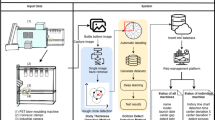Abstract
Product defect detection is an integral part of quality control process in any manufacturing industry. In many cases, this problem is solved by a specific designed system for each type of product, which often requires parameter tuning for each product model. In this paper, we propose a generic method for defect detection that can be deployed for various kinds of products and models. We detect defects on bottle surface and classify bottles accordingly. Bottle defect detection is a challenging task due to several factors like no sufficient training data, reflective (metallic) bottle surface, and visually similar defects with design patterns on bottles. To overcome these challenges, we first use a computer vision-based region detection technique called EREL to extract multiple regions of interest from training images and thus increase the volume of training data. The extracted regions are manually labelled as defective/non-defective. Then, we train our proposed CNN classifier to discriminate between defective and non-defective regions, based on the extracted regions and labels. Experimental results demonstrate superior performance on non-reflective bottles and acceptable performance of the proposed method with 77% accuracy on overall unseen test images, considering various kinds of bottles and challenging reflective metallic bottles. With a current modest personal computer, our method takes around 2.4 s to process an input image to generate final image with bounding boxes localizing the defects (if any).
Access this chapter
Tax calculation will be finalised at checkout
Purchases are for personal use only
Similar content being viewed by others
References
Bay, H., Ess, A., Tuytelaars, T., Van Gool, L.: Speeded-up robust features (SURF). Comput. Vis. Image Underst. 110(3), 346–359 (2008)
Faraji, M., Cheng, I., Naudin, I., Basu, A.: Segmentation of arterial walls in intravascular ultrasound cross-sectional images using extremal region selection. Ultrasonics 84, 356–365 (2018)
Faraji, M., Shanbehzadeh, J., Nasrollahi, K., Moeslund, T.B.: EREL: extremal regions of extremum levels. In: 2015 IEEE International Conference on Image Processing (ICIP), pp. 681–685. IEEE (2015)
Faraji, M., Shanbehzadeh, J., Nasrollahi, K., Moeslund, T.B.: Extremal regions detection guided by maxima of gradient magnitude. IEEE Trans. Image Process. 24(12), 5401–5415 (2015)
He, K., Zhang, X., Ren, S., Sun, J.: Deep residual learning for image recognition. In: Proceedings of the IEEE Conference on Computer Vision and Pattern Recognition, pp. 770–778 (2016)
Kingma, D.P., Ba, J.: Adam: a method for stochastic optimization. arXiv preprint arXiv:1412.6980 (2014)
Krizhevsky, A., Sutskever, I., Hinton, G.E.: Imagenet classification with deep convolutional neural networks. In: Advances in Neural Information Processing Systems, pp. 1097–1105 (2012)
Lin, J., Chiu, C.T.: LBP edge-mapped descriptor using MGM interest points for face recognition. In: 2017 IEEE International Conference on Acoustics, Speech and Signal Processing (ICASSP), pp. 1183–1187. IEEE (2017)
Lowe, D.G.: Distinctive image features from scale-invariant keypoints. Int. J. Comput. Vis. 60(2), 91–110 (2004)
Nair, V., Hinton, G.E.: Rectified linear units improve restricted Boltzmann machines. In: Proceedings of the 27th International Conference on Machine Learning (ICML 2010), pp. 807–814 (2010)
Ren, S., He, K., Girshick, R., Sun, J.: Faster R-CNN: towards real-time object detection with region proposal networks. IEEE Trans. Pattern Anal. Mach. Intell. 39(6), 1137–1149 (2017)
Srivastava, N., Hinton, G., Krizhevsky, A., Sutskever, I., Salakhutdinov, R.: Dropout: a simple way to prevent neural networks from overfitting. J. Mach. Learn. Res. 15(1), 1929–1958 (2014)
Szegedy, C., et al.: Going deeper with convolutions. In: CVPR (2015)
Author information
Authors and Affiliations
Corresponding author
Editor information
Editors and Affiliations
Rights and permissions
Copyright information
© 2018 Springer Nature Switzerland AG
About this paper
Cite this paper
Patel, N., Mukherjee, S., Ying, L. (2018). EREL-Net: A Remedy for Industrial Bottle Defect Detection. In: Basu, A., Berretti, S. (eds) Smart Multimedia. ICSM 2018. Lecture Notes in Computer Science(), vol 11010. Springer, Cham. https://doi.org/10.1007/978-3-030-04375-9_39
Download citation
DOI: https://doi.org/10.1007/978-3-030-04375-9_39
Published:
Publisher Name: Springer, Cham
Print ISBN: 978-3-030-04374-2
Online ISBN: 978-3-030-04375-9
eBook Packages: Computer ScienceComputer Science (R0)




